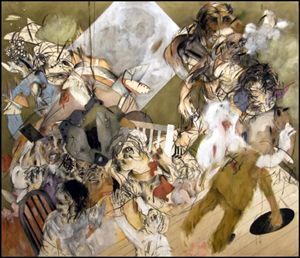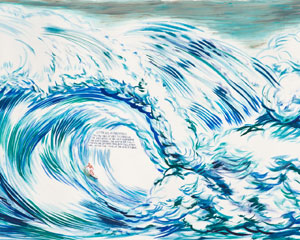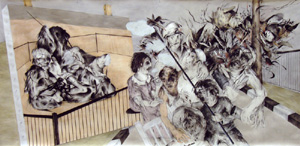The Executioner's Face
John Haberin New York City
Raymond Pettibon and Ahmed Alsoudani
Art after 9/11 has not always gone in for drama or even violence. Like politics itself, artists often pushed images of war to the side. Nearly five years into war, though, violence in political art is coming back.
One may not associate Raymond Pettibon right away with politics rather than impulse, celebrity, and a style somewhere between graphic novels and graffiti. As a Yale graduate, no doubt, Ahmed Alsoudani is steeped in Modernism, and one knows where that led. Where, then, does political art begin and end? Even beyond subject matter, as it turns out, a little violence does painting some good. This article continues the story of a still more explosive show, "Love/War/Sex" at Exit Art. 
Violence at last
Has political art, especially antiwar art, ever shown so little violence? Even today, one can hardly look at Goya's dark works or Manet's executioners without flinching. Guernica stills define the disasters of war for modern eyes. While art after 9/11 has flourished, as often as not it has shielded its eyes, even with "September 11" nearing its tenth anniversary and with the opening of the National September 11 Memorial. And it is not hard to imagine why. In a sense, art is all about indirection, and recently that fact, too, has political overtones.
The administration did its best to keep Iraq off the home screen, and artists have bravely responded to just that. Perhaps their first and best contribution was to embody an alternative to fear. Art could look toward Ground Zero with hope. It could point to silences, in censorship and in the headlines. With Jenny Holzer, Holzer's crawl screens, and Holzer's redaction paintings, the price of war lies forever hidden behind the censor's ink. With Hans Haacke and his political art, it hides behind the American flag.
With Amy Wilson, torture appears like a riddle. With Fernando Botero or Leon Golub, it appears like a pose within a stage play or a sexual ritual. Images like the hooded figure from Abu Ghraib remain in memory not from their explicit nature so much as from their muteness. The executioner's face is always well hidden.
I am generalizing too much again, but the lack of violence finally hit me, thanks to two clear exceptions—Raymond Pettibon and Ahmed Alsoudani. For Pettibon, confronting the worst amounts to an act of atonement. He calls the display "Here's Your Irony Back," and he means at least in part his own. The ultimate in slacker celebrity is getting serious.
 Pettibon turns out drawing after drawing, almost from floor to ceiling, separated by a warped Jewish star. Stark messages about war, President Bush, America, and Israel appear alongside, scrawled directly on the garage-like walls. The drawings mix still more handwritten block letters with scenes of horror, from coffins to tears, smeared and outlined in plenty of red and black. Pettibon has not left behind his roots in LA youth culture either, as seen in the paper loosely affixed to the walls and the unedited production. Like the smears and associations, too much of the violence has more to do with the artist's self-expression and maybe anti-Semitism than the costs of war.
Pettibon turns out drawing after drawing, almost from floor to ceiling, separated by a warped Jewish star. Stark messages about war, President Bush, America, and Israel appear alongside, scrawled directly on the garage-like walls. The drawings mix still more handwritten block letters with scenes of horror, from coffins to tears, smeared and outlined in plenty of red and black. Pettibon has not left behind his roots in LA youth culture either, as seen in the paper loosely affixed to the walls and the unedited production. Like the smears and associations, too much of the violence has more to do with the artist's self-expression and maybe anti-Semitism than the costs of war.
The texts go well beyond brief titles, and Pettibon might do well to remember that in cyberspace blocks of capital letters mean shouting. The caricatures and the horrors of war may recall Otto Dix and Berlin Dada before the optimism of Dadaglobe. However, the muscular bodies, their fluidity somewhere between action and melting, and the blunt repetition comes much closer to American poster art of the 1930s and 1940s. Those posters might have urged on socialism or the war effort, but Pettibon does not deal easily with specificity or nuance. Fans will find the political message and the familiar, impulsive style doubly rewarding and mutually supportive. As for me, I wanted my irony back.
Finding the victims
I wanted art to get more complicated as well. I wanted critical impulses inseparable from second thoughts. I wanted personal impulses that ranting or lectures can wash out. How else could art deal with war?
With Ahmed Alsoudani I found them. Like Pettibon, he looks back to classics like Goya and Picasso to describe Baghdad, his native city. One can locate male tormenters and sorrowful women. This time, however, the artist makes it tough to tell them apart.
 The tangled and twisted bodies owe something, too, to Francis Bacon, but without the raw meat. Black outlines and tan patches may even recall another love-hate relationship with bodies in motion, in a huge admirer of Guernica, Jackson Pollock. The gallery labels Alsoudani's work only as mixed media, but I am guessing charcoal and washes. Again large paintings approach the impulse of drawing.
The tangled and twisted bodies owe something, too, to Francis Bacon, but without the raw meat. Black outlines and tan patches may even recall another love-hate relationship with bodies in motion, in a huge admirer of Guernica, Jackson Pollock. The gallery labels Alsoudani's work only as mixed media, but I am guessing charcoal and washes. Again large paintings approach the impulse of drawing.
Alsoudani does not make all that clear what is going on. The compositions avoid Manet's facelessness, Bacon's solo dramas, or Picasso's monumentality. The figures gain instability by clustering between open spaces and fenced-in areas. They could stand for cities, prisons, or echoes of Goya's bull rings. Long pole-like objects, the only visible weapons, may seem more appropriate to a bullfight than to Donald Rumsfeld's high-tech army anyway.
Events have left a horrifying absence at Ground Zero, and artists have responded. They have supplied monuments to 9/11, where New York City still cannot. Sue Coe in graphic painting, "Love/War/Sex," or Pettibon may seem hectoring by comparison. Alsoudani can picture violence, but not only that.
When Goya makes it either too easy or too hard to sort out victims and victimizers, he comments on dehumanization. Here the difficulty may reflect the reality of a nation somewhere between occupation, civil, war and chaos. The strange thing is that the crowded landscapes can look empty and even beautiful.
No more war
Almost by definition, an Iraqi-born artist is in transition. Sure enough, almost in no time Alsoudani appears again, sharing a room in Chelsea with Christine Ay Tjoe. His very open spaces lead naturally to more ambiguous subjects and feelings. Even on first glance, the paintings seem warmer, more colorful, and less anxious. Signs of war appear less explicitly, if at all. In structure, however, the works still deal with crowd control, and they invite one to find one's place in the crowd.
They again rely on a neutral ground, although now ranging from a brighter tan to darker, almost olive greens. That alone holds Picasso and Pollock at a greater distance, and it may suggest the deeper space of atmospheric perspective. More white, too, amid the charcoal drawing also gives more space to breathe. I could swear I caught a hint or two of nature or sustenance—a bird or a bunch of grapes. The oil and acrylic washes include red, yellow, and blue now. A rough background texture gives the thin layers at times the appearance of pastel. Things are lightening up.
The space itself looks clearer, with more open planes supporting the figures and outlining a room's walls and floor. People have a place to stand, and some even get a chair. Others make direct eye contact with the viewer. One figure reaches up in agony or a plea for help, and someone to the left turns away, but the person immediately above seems almost meditative rather than horrified or indifferent. Someone reaches forward in an embrace, like the mother in a Pietá, and in place of a dead son a grown man puffs away on a cigar. They seem resigned—or determined—to look after themselves.
The clearer contrast between object and space brings out the structural devices in the previous show. Where the drawing added up to interlaced curves in frantic motion, now the actors fill out a larger circle. In one, the lightest plane peaks at top center, to complete a pyramid. All right, one might say, Guernica again, and more than enough is still going on. Some figures tumble into the mess, leaving the soles of their shoes, while others fade altogether into the washes. No one truly interacts, and no one at all is having a good time.
I have no idea what is going on here, but that may be the point. Are those three figures tied to a pole for execution or just hanging out, is that ladder for burglary or escape, and why is that backpack lying on the floor? A scene like this retains its vestige of humanity without the residual didacticism, but it has enough anxiety to go around regardless. Tjoe's neutral palette, bubbly drawing, and unclear shapes could pass for studies toward his scenes, and they go well together. Where Alsoudani's paintings grow harder to grasp as one approaches, hers look abstract until one stands back and they congeal, more or less, into heads. One could almost call them portraits, and Alsoudani, too, has tried something similar, with his brightest colors so far.
I did not know when ambiguity becomes indulgence or whether to miss the frank violence of war. For now, I like the greater range of creature comforts. One cannot always make out a subject in Abstract Expressionism either, other than that the party seems in progress. One way or another, however, people here are obviously dealing with conflict. One recent painting of Alsoudani's depicts the blocks for winners at an Olympics, but no one behind those gas masks is crowing in triumph. For sheer illustration, one always has Pettibon.

Raymond Pettibon ran at David Zwirner through October 20, 2007, Ahmed Alsoudani at Thierry Goldberg through October 14 and again at Mehr with Christine Ay Tjoe through February 9, 2008. This article continues a review of political art at the start of 2008, with "Love/War/Sex" at Exit Art. A related review catches up with Pettibon in retrospective.




